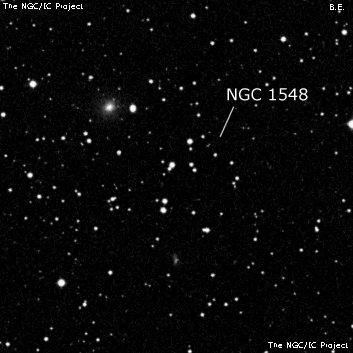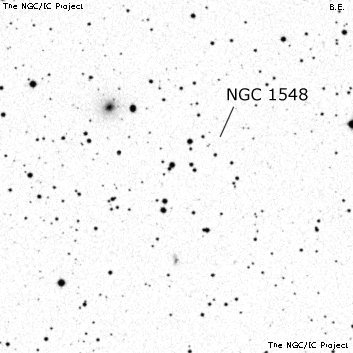NGC/IC Project Restoration Effort
(This is a very very beta version)
NGC1548


Basic Information
Location and Magnitude
Right Ascension: 4:20:49.6
Declination: +36:53:55
Constellation: PER
Visual Magnitude:
Historic Information
Discoverer: Herschel J.
Year of discovery: 1832
Discovery aperture: 18.3
Observational
Summary description: Cl, vL, lRi, lC, st 10…12
Sub-type: *Grp
Corwin's Notes
=====
NGC 1548. There isn't much to write home about at JH's catalogued position.
Some have tried to make a cluster out of the scattering of stars here, but it
is really no more than a random Milky Way field. This is all that Steve
Gottlieb saw in February 2010 when he went over the area. There is a galaxy
group in the background, but JH does not mention any nebulae in his
observation.
However, about 20 arcminutes south and west, Steve found a "cluster" that
doew look something like JH's description: "The chief star of a very loose,
poor cluster 30 arcmin diameter, little compressed; stars 10...12m." He has
it in only one sweep from 3 February 1832. The "chief star" is HD 27403,
exactly 20 arcminutes south of JH's nominal position.
Checking the other objects in JH's sweep that night, I found NGC 1778 = h344,
and NGC 1857 = h 350. While JH's position for N1857 is correct, his place for
N1778 is, like that for N1548, 20 arcmin too far north. This makes the group
of stars that Steve noticed almost certainly the cluster that JH saw. Steve
makes it only 20 x 10 arcmin visually, but pulling in some of the other stars
around the core, I can stretch it pretty easily to 25 x 25 arcmin across.
In any event, it is pretty clear that Steve has recovered JH's object.
Steve's Notes
=====
NGC 1548
18" (2/14/10): at 175x there was nothing that looked remotely cluster-like in the 35' field or that I felt might have caught Herschel's attention -- just a random scattered star field with no denser groupings. At 73x (67' field), though, my attention was drawn to mag 7.7 HD 27403 on the south side of the eyepiece field. Extending to the west and southwest of this brighter star was an elongated group highlighted by an oval ring, roughly 10' diameter with several mag 10 stars. A collection of fainter stars that follows the oval ring extends the overall dimensions to 20' x 10'.
Still, the asterism I described was unimpressive and not rich enough to mimic a cluster, but seemed the best fit in the nearby area to Herschel's object. If this group is Herschel's h312, then his position for the brightest star is exactly 20' N of HD 27403 and matches in RA, so a single digit error in dec would explain the discrepancy.



